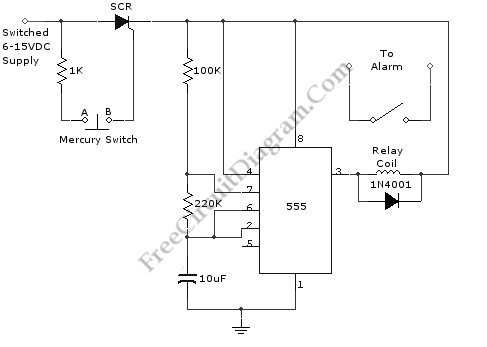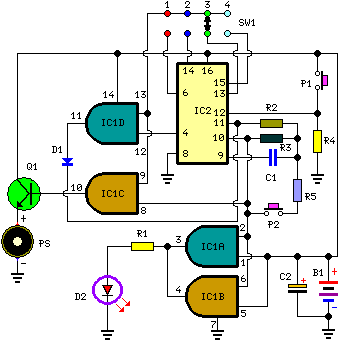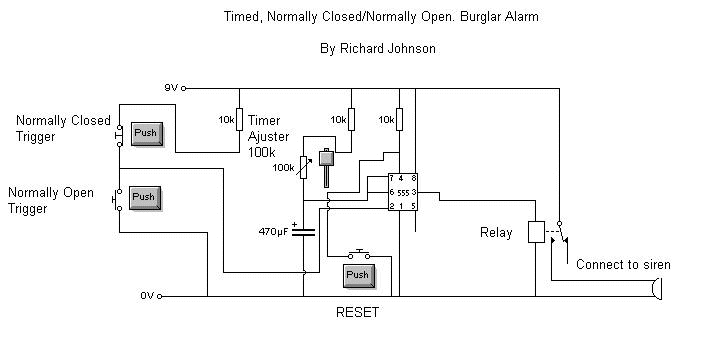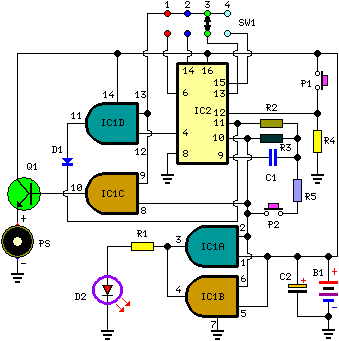
555-IC Timed Beeper/Alarm

This is a simple circuit of a beeper using a 555 timer. This circuit can be employed to energize lights, horns, or other signaling devices at any desired interval.
The 555 timer is a versatile integrated circuit widely used in various timing, pulse generation, and oscillation applications. In this beeper circuit, the 555 timer is configured in astable mode, allowing it to generate a square wave output that can be utilized to activate signaling devices such as lights or horns.
The circuit typically includes a few essential components: the 555 timer IC, resistors, a capacitor, and the signaling device itself. The resistors (R1 and R2) and the capacitor (C1) determine the frequency and duty cycle of the output waveform. The output frequency can be calculated using the formula:
\[ f = \frac{1.44}{(R1 + 2R2) \times C1} \]
Where:
- \( f \) is the frequency in hertz (Hz),
- \( R1 \) and \( R2 \) are the resistances in ohms (Ω),
- \( C1 \) is the capacitance in farads (F).
In this configuration, the output pin (Pin 3) of the 555 timer connects directly to the signaling device. When the circuit is powered, the 555 timer oscillates between high and low states, causing the connected device to turn on and off at the specified interval.
To adjust the timing interval, one can modify the values of R1, R2, and C1. Increasing the resistance or capacitance will result in a longer interval, while decreasing them will shorten the interval. This flexibility makes the beeper circuit suitable for various applications, including alarms, timers, and notification systems.
The circuit can be powered by a standard DC power supply, and it is advisable to include a diode across the signaling device to prevent back EMF, which could potentially damage the 555 timer. The circuit's simplicity and effectiveness make it a popular choice for hobbyists and professionals alike in electronic projects requiring timed signaling.This is a simple circuit of beeper using 555 timer. This circuit can be employed to energize lights, horn, or other signaling device at any desired interval. 🔗 External reference
The 555 timer is a versatile integrated circuit widely used in various timing, pulse generation, and oscillation applications. In this beeper circuit, the 555 timer is configured in astable mode, allowing it to generate a square wave output that can be utilized to activate signaling devices such as lights or horns.
The circuit typically includes a few essential components: the 555 timer IC, resistors, a capacitor, and the signaling device itself. The resistors (R1 and R2) and the capacitor (C1) determine the frequency and duty cycle of the output waveform. The output frequency can be calculated using the formula:
\[ f = \frac{1.44}{(R1 + 2R2) \times C1} \]
Where:
- \( f \) is the frequency in hertz (Hz),
- \( R1 \) and \( R2 \) are the resistances in ohms (Ω),
- \( C1 \) is the capacitance in farads (F).
In this configuration, the output pin (Pin 3) of the 555 timer connects directly to the signaling device. When the circuit is powered, the 555 timer oscillates between high and low states, causing the connected device to turn on and off at the specified interval.
To adjust the timing interval, one can modify the values of R1, R2, and C1. Increasing the resistance or capacitance will result in a longer interval, while decreasing them will shorten the interval. This flexibility makes the beeper circuit suitable for various applications, including alarms, timers, and notification systems.
The circuit can be powered by a standard DC power supply, and it is advisable to include a diode across the signaling device to prevent back EMF, which could potentially damage the 555 timer. The circuit's simplicity and effectiveness make it a popular choice for hobbyists and professionals alike in electronic projects requiring timed signaling.This is a simple circuit of beeper using 555 timer. This circuit can be employed to energize lights, horn, or other signaling device at any desired interval. 🔗 External reference





